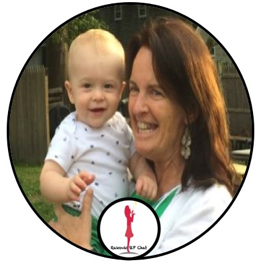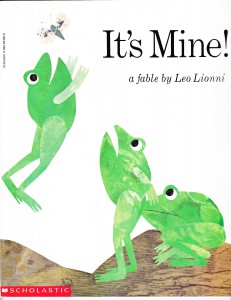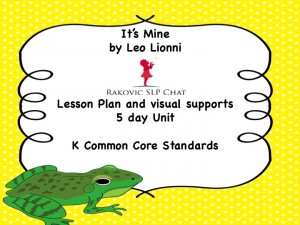In class I am using “Text Talk”. This program delivers direct vocabulary instruction of sophisticated words, combined with rich talk about text, to provide students with critical language and reading comprehension skills. This scientifically based program has been proven effective in raising students’ knowledge of vocabulary, an essential component for literacy development.
Text Talk focuses on robust words and are not the Tier 1 words (everyday words) or Tier 3 words (curriculum specific words) We call these words Tier 2.
The program takes advantage of some of the sophisticated vocabulary found in books for young children. I will be sending home new words. These words we are learning and using in our daily conversations and organized activities. I have asked the families to use these words in as many contexts and as often as possible. I want them to make a game of it!
The first story we are reading is “ It’s Mine!” by Leo Lionni. The words we will work on from this story are:
- bickering
- defiantly
- desperately
- recognized
- harmony
- selfish
In a first grade class the teacher had stepped out for a moment when I was teaching the vocabulary. I told the children to raise their hands and when the teacher came in tell her that you desperately needed a drink. The children loved it.
The story is a great one for the beginning of the year as it teaches sharing and working cooperatively.
We will also be practicing the comprehension strategy of summarizing.
After using this story and texttalk I have made a unit that also includes visuals, writing, story grammar and Blooms questions
This 5-day unit breaks down to
Day 1: Activating Prior Knowledge: lesson that requires the students to work as a team to accomplish a task.
- Drawing Response
Day 2: Reading the story and working with story grammar so the students get the concepts of
o Character
o Setting
o Emotions
o Initiating Event
o Problem/ Plan/Solution
o Resolution
Comprehension question given with page numbers
•
Day 3: Re-read with the students acting out the character using visual stick puppets
Day 4 Explicit instruction in Tier Two vocabulary
Day 5 Culminating Written Response:
What school rule would they have that would create harmony?
https://www.teacherspayteachers.com/Product/Common-Core-Kindergarten-Unit-Using-Literature-Its-Mine-Tier-Two-Vocabulary-2043593




I have a question. I am an SLP in a middle school. I print out short stories (usually non fiction) at the students instructional level, place it in front of them and after activating prior knowledge, review Tier 2 vocabulary etc. I read the passage to them. Would this be considered listening comprehension with visual ?
As it is read to them this would make it listening comprehension. Are you counting that the passage is in front of them as the visual? One thing that I would suggest would be to use of graphic organizer or to teach them how to do highlighting for key information. Then if you are looking at how to write a goal for this it could be ” By…. after activating prior knowledge and reviewing Tier 2 vocabulary the student will be able to answer ‘wh’ questions when provided a graphic organizer with 80% accuracy.” Non-fiction is different than fiction, and this blog is written about fiction. Listening for important details in non-fiction you want to work on the the structure of non-fiction. Here is a reference to some great information on non-fiction listening comprehension. http://www.readingrockets.org/article/nurturing-inquiring-mind-through-nonfiction-read-aloud
Hi! I like the goal that you wrote and I thank you for your help. My next two questions would be… what would you write in the goal as far as the passage being placed in front of them while I read? Would you specify that the paragraph/passage was at the student’s instructional level? Thanks!
I agree with Nicole that I love the family involvement as well. When students can see material outside of the classroom it helps them to better get a grasp on their new words. I also agree that this class has better defined which vocabulary words are important to teach- and to leave tier 3 to specific academic purposes and the tier 2 are the most important.
In a secondary math context we do vocabulary based on sections and what is important that unit. Since it is very content specific, we have placed emphasis on those tier 3 specific vocab. I’m thinking that this coming year, I place more emphasis on the necessary terms that carry through each unit of geometry for the year and are truly essential to understanding of all topics.
My question about these tier 2 vocab words are if they are the same as the weekly spelling tests that are popular in elementary school.
No, and they really shouldn’t be part of the spelling homework. Typically the spelling is based on some phonics rules that they are learning.
I love this idea. First of all, I think that providing ways to make vocabulary exciting is a great way to motivate students to learn about words in context but also encourage students to practice using vocabulary in everyday settings. I can imagine that this would greatly improve retention, but more importantly, create meaningful experiences for students.
This lesson also includes the family in the integration of the new vocabulary. Providing multiple experiences and opportunities for the students to hear and interact with words is crucial to new understanding.
I feel that this lesson would be valuable to ELL students as well, as there are opportunities to create rich and meaningful ways for students to introduce their school vocabulary and language at home. Bridging this gap makes way for more communication between home and school and ease transitions between language. It can also serve as a diagnostic for what kind of language is used at home (pragmatically speaking).
Through this class, I finally feel that I have a better understanding of tiered vocabulary. I look forward to trying some of these types of lessons with my students but also reaching out to our SLP’s to try to work more collaboratively for some of the language and communication needs for our students.